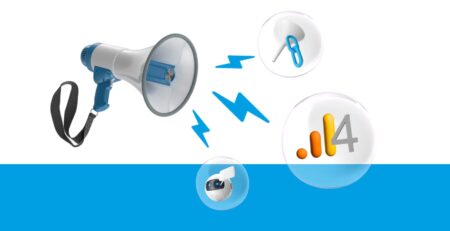What you can do with a free Semrush account
Building your SEO toolkit is generally dictated by two things: your budget and your goals. This makes test-driving tools and platforms an ideal way to figure out which platforms provide the features that you need most, and lets you determine just how much you have to invest in tools to access them. Many platforms offer free trials, but they can be very limiting. One tool we use at Brainlabs is Semrush. A free Semrush account offers a sampling of their features, and their 7-day trial gives users full access to all features to test them out.
As mentioned above, we regularly use Semrush at Brainlabs. If we were to maximize our use while tightening our purse strings, however, what would we do with the free option?
The short answer: Many of the same things we would do with a paid subscription, the caveat being that the reports and data we pull will be limited to just a handful of results. To get a clearer view of our options, let’s look into the benefits and limitations of a free Semrush account,
What are the Limitations of a Free Semrush Account?
First things first: Let’s talk limits. As comprehensive as the Semrush free account is, it still only offers users a sampling of the features of a paid account. To get the most out of a free account, a low-budget marketer should know these limitations before starting. Otherwise, you could risk going over budget on each feature too quickly before you’ve had a chance to leverage each one.
As a general rule, you can access up to 10 listed results. For more involved features such as reports, you can create one of each. Below is an overview of some popular tools and their limitations:
- 10 searches per day
- 10 results per search
- Max 100 pages crawled for the site audit
- 10 keywords to track
- 10 idea units for On Page SEO Tracker
- 1 SEO content template
- 1 SEO Writing Assistant template
- 1 Keyword Magic Tool list
- 2 search queries in Topic Research
- 1 PDF report
Now that we know our boundaries, we can determine the best tools to use.
Keyword Research
Domain Overview
As imperative as keyword research is to any digital content marketing strategy, adding in a limited budget makes this even more challenging. Thankfully, the keyword tools within Semrush are extensive, and luckily, you have access to many of these via their free account. You can view a URL’s top organic keywords by position, volume, cost per click, and traffic, all under Domain Overview.
Simply enter a URL into the Organic Research search bar to see that domain’s top organic keywords, position changes, competitors, SERP features, top pages, and top subdomains.
Beware that each of these reports counts toward your 10 searches per day maximum, so we recommend planning out searches for the week to see which keywords are your top priority and execute those first.
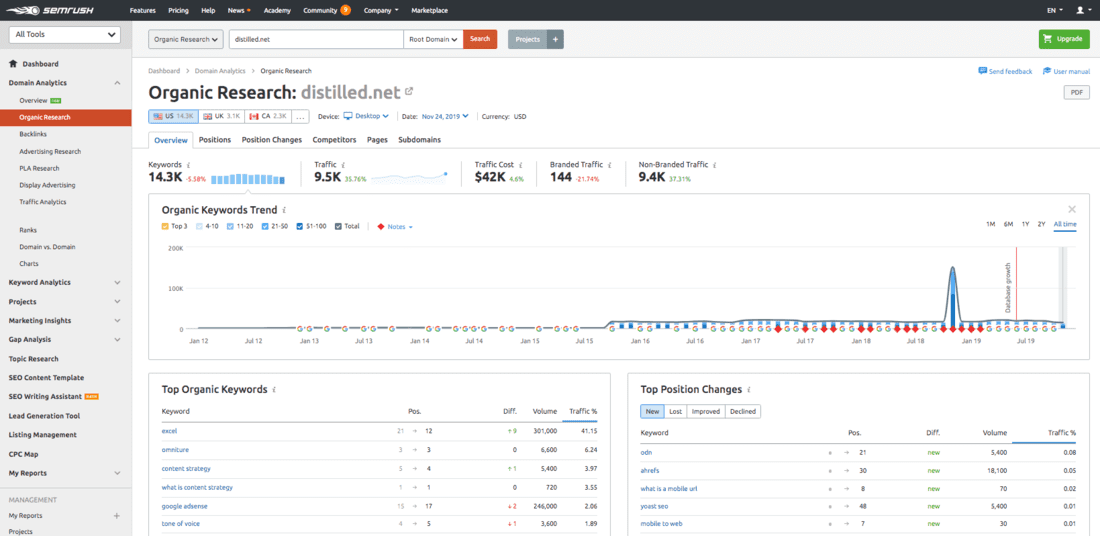
Organic position tracking
The Keyword Overview is an excellent resource to kickstart keyword research on a budget. Search up to 10 keywords per day to monitor how you and your competitors rank for specific keywords and related terms.
Keyword magic tool lists
Use this keyword research tool to narrow in on niche terms and optimize your content with long-tail keywords. This is especially useful if you’re building a hub and spoke model. Once you determine the hub topic you want to concentrate on, the Keyword Magic Tool provides related terms to add to your content strategy. The trial offers up to 10 keyword suggestions, so have your topics in mind before starting to search.
Backlinking
Backlink analysis
It’s important to identify who links to your site and where, and to eliminate spammy links to your site. While it may not stand in for a full competitor backlink audit, Semrush’s Backlink Analysis does have its benefits for marketers looking to manage their backlinks within budget. This tool lets you view backlinks by link type, link attribute, country, domain category, and key anchor terms to pinpoint where your content gets the most traction.
Semrush also provides its own domain Authority Score to help you determine the quality of backlinks to your site. Monitoring the value of your backlinks can help increase your site’s visibility and rankings, making them an important component in your overall SEO strategy. The tool’s Authority Score is based on an amalgamation of various data points including Page Score, Domain Score, and Trust Score. In using it to determine which links are most and least valuable, you can clean up your backlinking profile.
You can also easily keep track of your backlinks by viewing a chart of your lost and gained backlinks over the past 3 months, full year, or of all time.
If you need a more in-depth, semi-automated analysis of your backlinks, the Backlink Audit Tool is a useful option for an initial audit to locate and clean up irrelevant or spammy links.
Backlink gap
If you want to take a closer look at your competitors’ backlinks and find some leads yourself, Semrush’s Backlink Gap is a helpful tool. Plus, the 10 results you get in the trial put you in a good position to start your backlink campaign.
With this tool, you can compare your domain to up to four others. You will get two views of their backlinks–a chart and a table. For each domain you compare, you’ll see who links to them and the Authority Score of each linking domain.
On-Page SEO/Content
SEO content template
Once you know which keywords you want to target, you can start developing content ideas with Semrush’s SEO Content Template. Enter the keywords you aim to rank for, and you’ll be presented with your top 10 Google competitors for those keywords, partnered with recommendations to challenge them. On-page recommendations include semantically related keywords, backlinks to acquire, a suggested readability score, recommended metadata, and suggested content length.
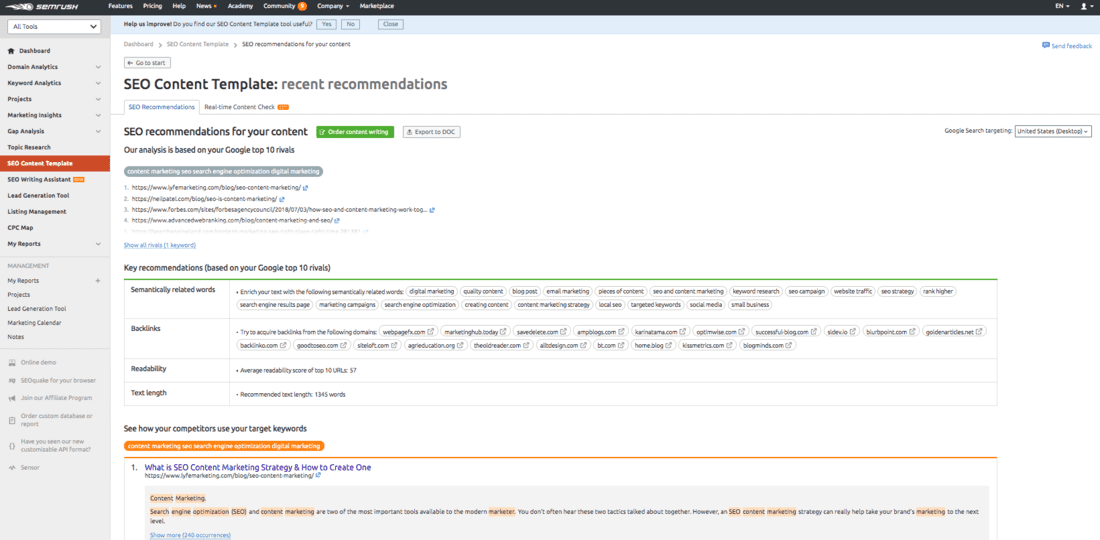
From here, you can access the On Page SEO Checker which gives you real-time feedback on your content. This way you will know right away if your content follows SEO best practices while also competing with your top-ranking URLs/ Google rivals.
Content Strategy
Topic research
Developing content ideas can be challenging. The Topic Research tool can help with the brainstorming process by providing potential topics and sub-topics to create content around. You can see the terms your competitors are ranking for and find gaps in their content with this free account. Run a comprehensive Keyword Gap analysis and search by country, device type, and the date range you need.
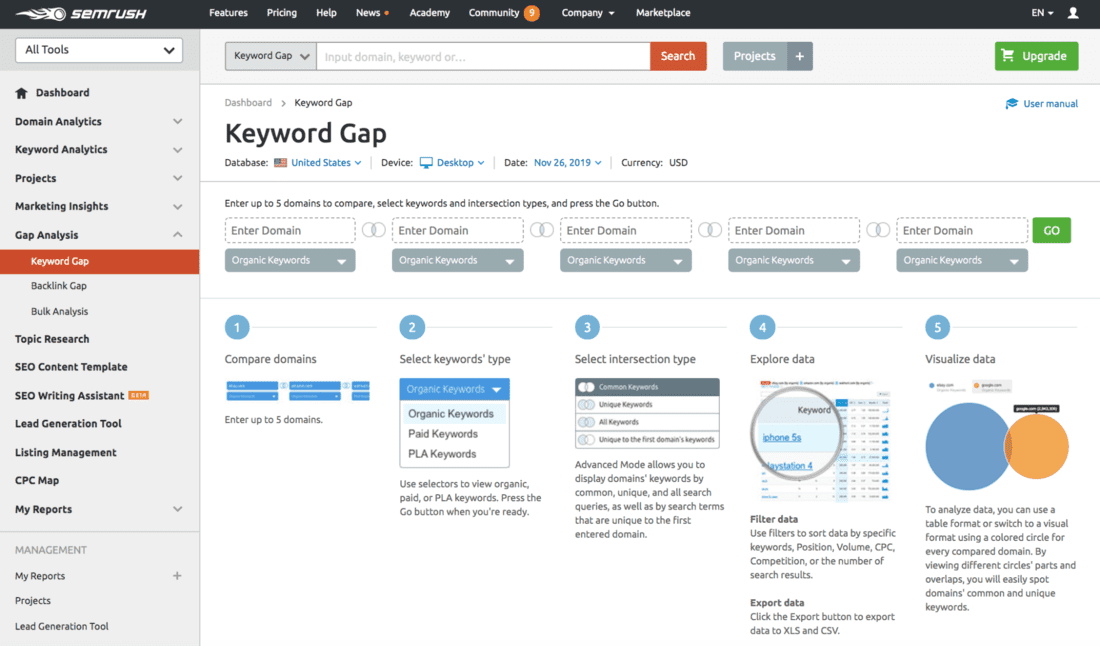
Pulling the data is easy. Simply enter up to five URLs that you want to compare in the respective search boxes and select the types of keywords you want results for. Choose from organic, paid and PLA keywords depending on the campaign you’re planning. You can then specify your results further by selecting the intersection you want to explore. Whether you want to see the keywords you and your competitors have in common or you’re looking for gaps in their content, you can narrow in on the data you receive based on that goal.

Lastly, hit “Go” to start your data pull.
From there, you can filter your data within the tool and analyze it via the various charts and diagrams available. Alternatively, you can easily export your keyword data into XLS or CSV format and analyze from there. The choice is yours. Be aware that this is a trial, however, so you will only see the first 10 results for any given intersect and each data pull will go against your daily maximum of 10 queries.
Tracking and Reporting
Create a project
If you’re looking for the fullest view of your site, and have some time to dedicate to setting it up, the Project tool can be incredibly valuable. Set up the features you need most depending on your goals. Choose from 12 project-types ranging from a site tech audit to a backlink audit, social media tracker, and PPC keyword tracking.
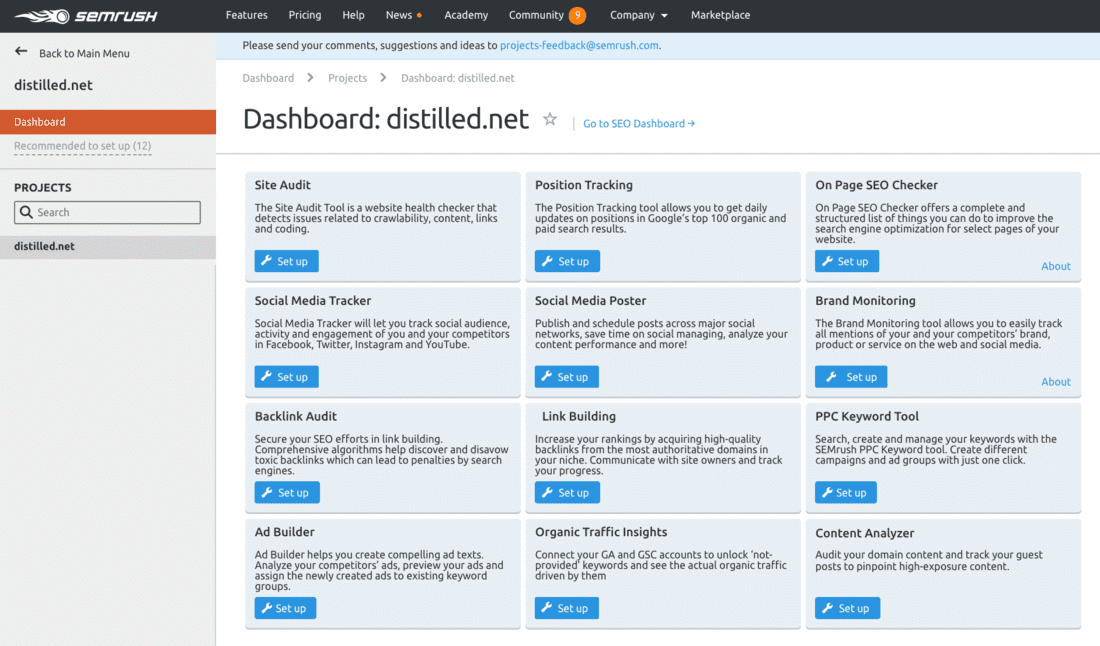
As you may have noticed, the tracking possibilities here are vast. To get you started, here are some of our most-used features that have the most functionality in the free account.
Site audit
If you’re looking for another crawling tool, you’re in luck! You can run a limited crawl with Semrush. Check for technical errors including broken internal links, long title tags, and missing h1 tags. Keep in mind that this free account version will only crawl 100 pages of your site, so this sampling will get you started and is ideal if you’re a super small site.
Position tracking
Use this tool to track your top-ranking keywords within a given project. To get started, simply set up your campaign: Select your root domain, search engine and device of choice, and your location. Semrush then pulls the top-ranking keywords for that domain. You can also upload keywords manually or through Google Analytics if you like, but that will be more helpful if/when you invest in a paid plan.
Once you have your list, you can add these top keywords to your project and start tracking them. After a minute or two, your Position Tracking dashboard will appear.
![]()
Here, you can monitor the progress of your keyword targeting. Track how your site ranks in the top three positions for the keywords you’re tracking and look for opportunity keywords on the second and third pages of the SERP. You can also compare rankings with competitor sites, monitor the success of select landing pages, and track any featured snippets you may have gained or lost over the week.
Backlink Audit
While there are a variety of tools out there to help you run a backlink audit, it’s worth testing out Semrush’s Backlink Audit during your free trial. This tool helps you quickly locate toxic backlinks and request their removal.
Once you run your audit, you can take a closer look at the backlink results. It marks each backlink with a score: 45-59 is potentially toxic and should be examined more closely; 60-100 is a toxic link and you should strongly consider removing it from your site.
Note: This tool is a guide, so before removing any links from your site it is important to review and analyze them.
If you do find toxic links in this audit, you can send requests to remove or disavow the links directly from Semrush.
Create a PDF report
If you have to bring your findings to a team of stakeholders or justify the value of Semrush to managers, you’ll likely enjoy one of the most comprehensive and advanced features on the Semrush’s free trial–the report feature.
Within the trial scope, you can create one report to communicate your digital marketing status. Choose from an array of templated reports or create your own from scratch. The drag and drop method comes in handy here as you can select the most relevant data points for your team and compile them into an easy-to-digest report.
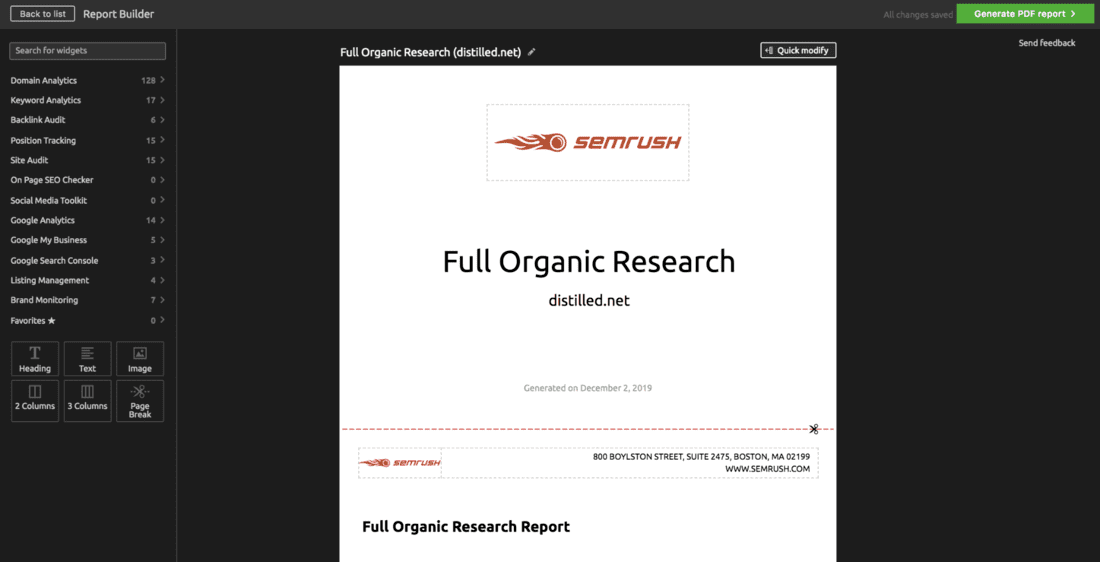
You can connect a domain’s Google Analytics, Google Search Console, and Google my Business accounts to instantly pull data from each source.
Additionally, choose from the wide variety of domain analytics Semrush can pull from its own platform into graphs, charts, and tables.
Don’t get too excited, though. Since the trial is free, you only get to create one report and your options for selecting data points are more limited than the paid accounts, so make sure you have a plan in mind before starting to create your report.
How to Make the Most of Your Account
Know which data points you want to research
Are you using the trial to suss out your competitors’ rankings, for instance, or are you more interested in building out your backlink strategy? Defining your goals and the data points you need to attain them is crucial to leveraging your free Semrush trial to its fullest, so we recommend having a clear idea of what you’re looking for before getting started.
Identify your most trafficked pages
It’s beneficial to define your best-performing content prior to starting your 7-day free trial. That way, you’ll know which URLs you want to look into first, as well as those that need additional optimization.
Prepare your keywords
If you already know which keywords you’re ranking for and want to take a closer look at your competitors or to flesh out your content strategy, be sure to gather those queries ahead of time. This will make it easier for you to check search volume and semantically-related keywords for relevant terms without blowing your search budget.
Have a list of possible competitors
Having a handful of competitors in mind can be extremely helpful when setting up your Semrush dashboards. While the tool will suggest your top Google competitors, it may not pick up on the more indirect competition. If you have a list of these companies prior to starting your trial, you can save a portion of your search budget to dig into your nuanced competitors while also discovering additional ranking rivals.
Leverage Google Search Console
Understanding your site’s current status will help you determine which direction to head in next. Google Search Console gives you insight into how you rank for various terms, and which pages resonate most with your audience. You can then use this information to retarget any pages that are ranking for irrelevant keywords, for example, within Semrush.
With these tips, you can comfortably get started with a free Semrush account, and make the most of your limited searches.


